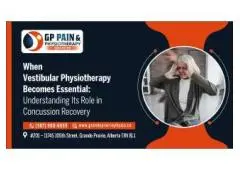Description
Dizziness is a common symptom that can significantly impact an individual's quality of life, to balance issues, falls, and a sense of disorientation. vestibular physiotherapy in Grande Prairie offers specialized interventions aimed at addressing the underlying causes of dizziness and restoring balance and stability. At G P Pain & Physiotherapy, we recognize the debilitating effects of dizziness and the importance of tailored vestibular physiotherapy interventions in helping individuals regain their equilibrium. In this article, we delve into the causes of dizziness, the role of vestibular physiotherapy, and the transformative effects it can have on individuals' lives.
Understanding Dizziness:
Dizziness encompasses a range of sensations, including vertigo (a spinning or whirling sensation), lightheadedness, unsteadiness, and feelings of faintness or floating. These symptoms can arise from various sources, including vestibular system dysfunction, inner ear disorders, neurological conditions, cardiovascular issues, medication side effects, and psychological factors. Dizziness can be triggered by changes in head position, sudden movements, visual stimuli, or prolonged standing, and it may be accompanied by nausea, vomiting, sweating, and anxiety.
The Role of Vestibular Physiotherapy:
Vestibular physiotherapy, also known as vestibular rehabilitation therapy (VRT), is a specialized form of physiotherapy designed to address dizziness and balance disorders resulting from vestibular system dysfunction. The vestibular system, located within the inner ear, plays a crucial role in maintaining balance, spatial orientation, and eye movement control. Vestibular physiotherapy aims to optimize vestibular function, enhance compensatory mechanisms, and improve overall balance and stability through a combination of exercises, maneuvers, and education.
Key Components of Vestibular Physiotherapy:
Vestibular physiotherapy interventions are tailored to each individual's specific symptoms, functional limitations, and underlying vestibular pathology. Some key components of vestibular physiotherapy include:
Assessment and diagnosis: A comprehensive evaluation is conducted to assess the patient's vestibular function, identify specific impairments, and determine the underlying cause of dizziness. This may involve tests of balance, gait, eye movements, positional testing, and subjective symptom assessments.
Canalith repositioning maneuvers: For individuals experiencing benign paroxysmal positional vertigo (BPPV), canalith repositioning maneuvers such as the Epley maneuver or Semont maneuver may be performed to reposition displaced otoliths (calcium carbonate crystals) within the inner ear's semicircular canals, alleviating vertigo symptoms.
Conclusion:
Vestibular physiotherapy offers effective solutions for individuals struggling with dizziness and balance disorders, empowering them to regain control over their lives and activities. Through targeted exercises, maneuvers, and education, vestibular physiotherapy addresses the root causes of dizziness, improves vestibular function, and enhances overall quality of life. At G P Pain & Physiotherapy, our experienced physiotherapists are dedicated to providing comprehensive vestibular rehabilitation tailored to each patient's unique needs, helping them overcome dizziness and achieve lasting stability and well-being.
https://tinyurl.com/d4x7pf28 , 780 830 3638
#vestibularphysiotherapygrandeprairie #vestibularphysiotherapy #vestibularphysiotherapynearme #vestibularphysiotherapy #gppainphysicaltherapy #grandeprairiephysiotherapy #physiotherapynearme #physiotherapygrandeprairie #physicaltherapygrandeprairie #physicaltherapynearme #physicaltherapy #physiotherapistclinic #physiotherapytclinic #physicaltherapyclinic #vestibularrehabilitation
#vestibularrehabilitationtherapy #vertigophysiotherapy #dizzinessphysiotherapy












